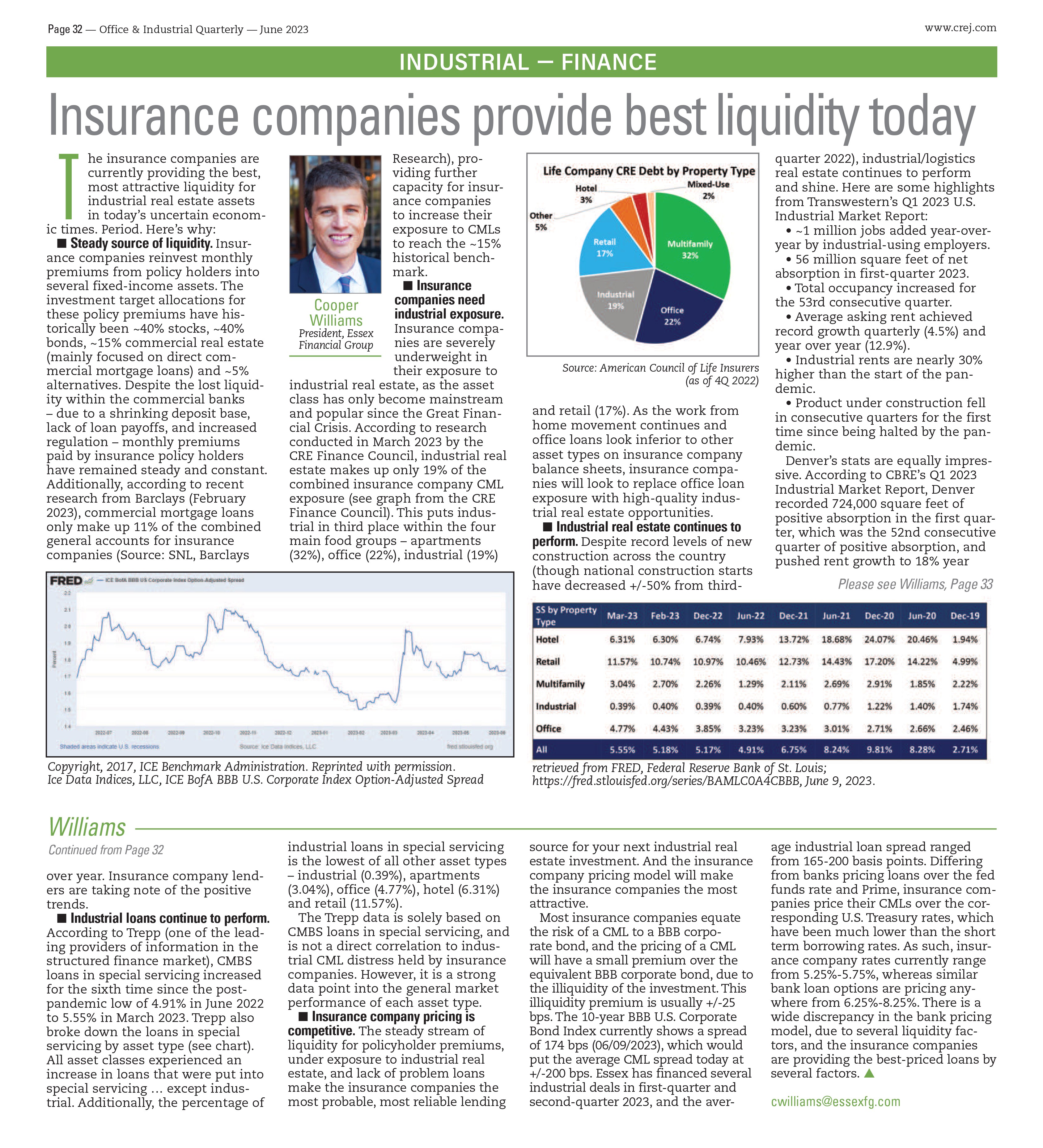The insurance companies are currently providing the best, most attractive liquidity for industrial real estate assets in today’s uncertain economic times. Period. Here’s why:
Steady source of liquidity. Insurance companies reinvest monthly premiums from policy holders into several fixed- income assets. The investment target allocations for these policy premiums have historically been ~40% stocks, ~40% bonds, ~15% commercial real estate (mainly focused on direct commercial mortgage loans) and ~5% alternatives. Despite the lost liquidity within the commercial banks – due to a shrinking deposit base, lack of loan payoffs, and increased regulation – monthly premiums paid by insurance policy holders have remained steady and constant. Additionally, according to recent research from Barclays (February 2023), commercial mortgage loans only make up 11% of the combined general accounts for insurance companies (Source: SNL, Barclays Research), providing further capacity for insurance companies to increase their exposure to CMLs to reach the ~15% historical benchmark.
Insurance companies need industrial exposure. Insurance companies are severely underweight in their exposure to industrial real estate, as the asset class has only become mainstream and popular since the Great Financial Crisis. According to research conducted in March 2023 by the CRE Finance Council, industrial real estate makes up only 19% of the combined insurance company CML exposure (see graph from the CRE Finance Council). This puts industrial in third place within the four main food groups – apartments (32%), office (22%), industrial (19%) and retail (17%). As the work from home movement continues and office loans look inferior to other asset types on insurance company balance sheets, insurance companies will look to replace office loan exposure with high-quality industrial real estate opportunities.
Industrial real estate continues to perform. Despite record levels of new construction across the country (though national construction starts have decreased +/-50% from third quarter 2022), industrial/logistics real estate continues to perform and shine. Here are some highlights from Transwestern’s Q1 2023 U.S. Industrial Market Report:
• ~1 million jobs added year-over-year by industrial-using employers.
• 56 million square feet of net absorption in first-quarter 2023.
• Total occupancy increased for the 53rd consecutive quarter.
• Average asking rent achieved record growth quarterly (4.5%) and year over year (12.9%).
• Industrial rents are nearly 30% higher than the start of the pandemic.
• Product under construction fell in consecutive quarters for the first time since being halted by the pandemic.
Denver’s stats are equally impressive. According to CBRE’s Q1 2023 Industrial Market Report, Denver recorded 724,000 square feet of positive absorption in the first quarter, which was the 52nd consecutive quarter of positive absorption, and pushed rent growth to 18% year over year. Insurance company lenders are taking note of the positive trends.
Industrial loans continue to perform. According to Trepp (one of the leading providers of information in the structured finance market), CMBS loans in special servicing increased for the sixth time since the post-pandemic low of 4.91% in June 2022 to 5.55% in March 2023. Trepp also broke down the loans in special servicing by asset type (see chart). All asset classes experienced an increase in loans that were put into special servicing … except industrial. Additionally, the percentage of industrial loans in special servicing is the lowest of all other asset types – industrial (0.39%), apartments (3.04%), office (4.77%), hotel (6.31%) and retail (11.57%). The Trepp data is solely based on CMBS loans in special servicing, and is not a direct correlation to industrial CML distress held by insurance companies. However, it is a strong data point into the general market performance of each asset type.
Insurance company pricing is competitive. The steady stream of liquidity for policyholder premiums, under exposure to industrial real estate, and lack of problem loans make the insurance companies the most probable, most reliable lending source for your next industrial real estate investment. And the insurance company pricing model will make the insurance companies the most attractive. Most insurance companies equate the risk of a CML to a BBB corporate bond, and the pricing of a CML will have a small premium over the equivalent BBB corporate bond, due to the illiquidity of the investment. This illiquidity premium is usually +/-25 bps. The 10-year BBB U.S. Corporate Bond Index currently shows a spread of 174 bps (06/09/2023), which would put the average CML spread today at +/-200 bps. Essex has financed several industrial deals in first-quarter and second-quarter 2023, and the average industrial loan spread ranged from 165-200 basis points. Differing from banks pricing loans over the fed funds rate and Prime, insurance companies price their CMLs over the corresponding U.S. Treasury rates, which have been much lower than the short term borrowing rates. As such, insurance company rates currently range from 5.25%-5.75%, whereas similar bank loan options are pricing anywhere from 6.25%-8.25%. There is a wide discrepancy in the bank pricing model, due to several liquidity factors, and the insurance companies are providing the best-priced loans by several factors.
